- Accueil
- Pages cachées
- 21 MAI 2023 NEWS
21 MAI 2023 NEWS
INSTITUT SUPERIEUR D'ANTHROPOLOGIE
INSTITUTE OF ANTHROPOLOGY
ONLINE COURSES / COURS A DISTANCE
DEBUT COURS : JUIN 2023
REGISTER NOW
SUEDE – 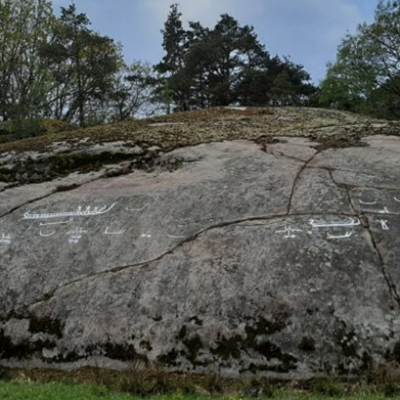
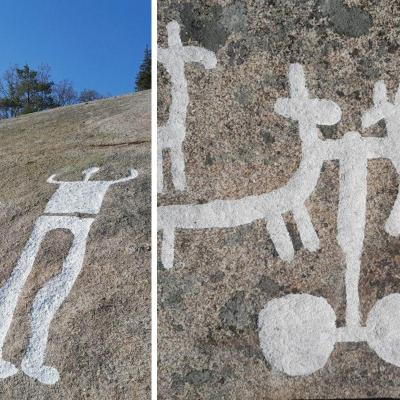 Bohuslan - Archaeologists have discovered a giant petroglyph in Bohuslan. The archaeologists were surveying a rock slab in a farm pasture when they noticed a tiny part of a ship beneath layers of moss. Removing the moss revealed a 15-metre-long petroglyph consisting of 40 figures showing ships, horses, people, and chariots. In total, the researchers have identified thirteen ships, nine horses, seven people, and four chariots. “These are very large things, including a two-metre ship and a person over one metre in height. The figures are well carved and deep. The motifs are not unique, but the location on an almost vertical outcrop is unusual”, says archaeologist Andreas Toreld. The carving has been dated to around the 7th–8th centuries BC during the peak of petroglyph carving in the Nordic Bronze Age. Bohuslän has a high concentration of similar petroglyphs, where examples of people, agriculture and stock raising, hunting and fishing, cult and religion (e.g. the Sun cross), carts, ships, and weapons can be found throughout the province. Due to the linear alignment of the figures, the researchers suggest that they were carved by artisans while stationary on a boat. At the time, the outcrop was part of an island, in which the petroglyph was carved just above the waterline that was darkened by cyanobacteria.
Bohuslan - Archaeologists have discovered a giant petroglyph in Bohuslan. The archaeologists were surveying a rock slab in a farm pasture when they noticed a tiny part of a ship beneath layers of moss. Removing the moss revealed a 15-metre-long petroglyph consisting of 40 figures showing ships, horses, people, and chariots. In total, the researchers have identified thirteen ships, nine horses, seven people, and four chariots. “These are very large things, including a two-metre ship and a person over one metre in height. The figures are well carved and deep. The motifs are not unique, but the location on an almost vertical outcrop is unusual”, says archaeologist Andreas Toreld. The carving has been dated to around the 7th–8th centuries BC during the peak of petroglyph carving in the Nordic Bronze Age. Bohuslän has a high concentration of similar petroglyphs, where examples of people, agriculture and stock raising, hunting and fishing, cult and religion (e.g. the Sun cross), carts, ships, and weapons can be found throughout the province. Due to the linear alignment of the figures, the researchers suggest that they were carved by artisans while stationary on a boat. At the time, the outcrop was part of an island, in which the petroglyph was carved just above the waterline that was darkened by cyanobacteria.
POLOGNE – Krasnystaw - Science in Poland reports that a 3,500-year-old bronze dagger was discovered near the surface of the soil in a forest in southeastern Poland by a metal detectorist. Paweł Wira of the Chełm Provincial Office for the Protection of Monuments said it is the first such weapon to be found in the region. He thinks it may have been lost by a traveler. “It is not a local product, the item most likely came here from today’s Hungary, Czechia, Austria or Slovakia—from the Danube area,” Wira explained. The dagger will be held at the Regional Museum in Krasnystaw.
https://www.archaeology.org/news/11444-230517-poland-bronze-dagger
ESPAGNE –  La Peña de los Enamorados - A 5,400-year-old megalithic tomb containing stone tools, pieces of pottery, and human remains has been found in southern Spain by Leonardo García Sanjuán of the University of Seville and his colleagues. Situated near the Matacabras rock shelter at La Peña de los Enamorados, or the Rock of the Lovers, light from sunrise on the summer solstice travels along a passage and onto a rock with distinctive ripples on its surface that had been placed in a cavity deep within the tomb. García Sanjuán explained that light striking the rippled rock may have been intended to create a symbolic or magical effect. “They worked very cleverly to make an arrangement of stones, which were engraved and possibly painted,” he said. The tomb is thought to have been used for burials for more than 1,000 years, beginning several hundred years after pictographs were first painted at the Matacabras rock shelter, he added. The researchers also note that the tomb at La Peña de los Enamorados is aligned with the megalithic monument known as the Dolmen of Menga, which is located about four miles away.
La Peña de los Enamorados - A 5,400-year-old megalithic tomb containing stone tools, pieces of pottery, and human remains has been found in southern Spain by Leonardo García Sanjuán of the University of Seville and his colleagues. Situated near the Matacabras rock shelter at La Peña de los Enamorados, or the Rock of the Lovers, light from sunrise on the summer solstice travels along a passage and onto a rock with distinctive ripples on its surface that had been placed in a cavity deep within the tomb. García Sanjuán explained that light striking the rippled rock may have been intended to create a symbolic or magical effect. “They worked very cleverly to make an arrangement of stones, which were engraved and possibly painted,” he said. The tomb is thought to have been used for burials for more than 1,000 years, beginning several hundred years after pictographs were first painted at the Matacabras rock shelter, he added. The researchers also note that the tomb at La Peña de los Enamorados is aligned with the megalithic monument known as the Dolmen of Menga, which is located about four miles away.
https://www.archaeology.org/news/11445-230517-spain-megalithic-tomb
ANGLETERRE –  Laxfield - The discovery was made during excavations at Laxfield, where trial trenching revealed a burnt mound complex and an enclosure system from the Bronze Age, in addition to the remains of three Iron Age roundhouses and evidence of medieval activity. Burnt mounds are enigmatic prehistoric features known from across the British Isles. Well-preserved examples are characterised by a flattened mound formed from discarded burnt stones. The stones were heated which functioned as “pot boilers”, heating water in nearby earth-cut, possibly timber-lined troughs. The purpose of burnt mounds is speculated, with one interpretation suggesting that they served as saunas for bathing. Other theories suggest dyeing or leather treatment, fulling, or for cooking. They are often found near a river, spring, or natural water source, however, for the example at Laxfield, a large pit or well was dug to the level of the water table. Dating the site was possible by a radiocarbon analysis of preserved organic plant material found in the waterlogged soils filling the well – indicating that the burnt mound ceased being active before the Middle Bronze Age. The enclosure system dates to around the Middle Bronze Age and was used for livestock farming, although this occurred after the activities of the burnt mound. The area of the enclosures became active again during the Iron Age, with the construction of three roundhouses and evidence of domestic waste. The larger of the roundhouses was dated by the Iron Age pottery and other finds from its surrounding gully, in addition to domestic waste dumped in the top of the adjacent Bronze Age ditch. Little associated evidence was found in the other two roundhouses to confirm a date, but the team suggest that these two are also from the Iron Age based on their locality to the larger roundhouse remains.
Laxfield - The discovery was made during excavations at Laxfield, where trial trenching revealed a burnt mound complex and an enclosure system from the Bronze Age, in addition to the remains of three Iron Age roundhouses and evidence of medieval activity. Burnt mounds are enigmatic prehistoric features known from across the British Isles. Well-preserved examples are characterised by a flattened mound formed from discarded burnt stones. The stones were heated which functioned as “pot boilers”, heating water in nearby earth-cut, possibly timber-lined troughs. The purpose of burnt mounds is speculated, with one interpretation suggesting that they served as saunas for bathing. Other theories suggest dyeing or leather treatment, fulling, or for cooking. They are often found near a river, spring, or natural water source, however, for the example at Laxfield, a large pit or well was dug to the level of the water table. Dating the site was possible by a radiocarbon analysis of preserved organic plant material found in the waterlogged soils filling the well – indicating that the burnt mound ceased being active before the Middle Bronze Age. The enclosure system dates to around the Middle Bronze Age and was used for livestock farming, although this occurred after the activities of the burnt mound. The area of the enclosures became active again during the Iron Age, with the construction of three roundhouses and evidence of domestic waste. The larger of the roundhouses was dated by the Iron Age pottery and other finds from its surrounding gully, in addition to domestic waste dumped in the top of the adjacent Bronze Age ditch. Little associated evidence was found in the other two roundhouses to confirm a date, but the team suggest that these two are also from the Iron Age based on their locality to the larger roundhouse remains.
IRAN – 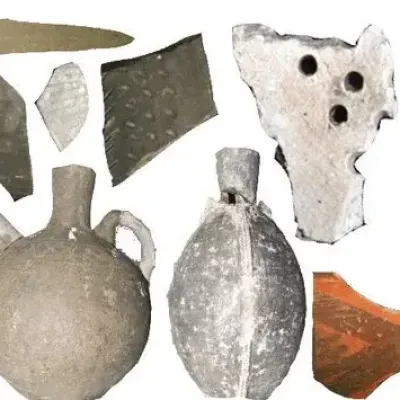
 Mazandaran - Archaeologists excavating in Iran’s Mazandaran region have revealed that Iranian farmers were cultivating rice as far back as 3000 years ago. Māzandarān is a historic northern Iran region bordering the Caspian Sea on the north. An early Iranian civilization flourished at the beginning of the first millennium BC in Tabarestan (Māzandarān). Based on the results of an archaeological survey conducted by experts from the Peking University, rice cultivation in the Mazandaran region dates some 3,000 years, ISNA quoted Iranian archaeologist Ebrahim Amirkolai as saying on Thursday. The study relies on evidence mostly accumulated from excavations conducted on Qale-Kesh, an archaeological site near Amol, the Amirkolai said. It shows that the history of this grain’s cultivation in Mazandaran goes back to the Achaemenid period and even further in time to 3,000 years ago, he explained. Furthermore, the excavations discovered traces of sand, which, according to the geographers, suggests that the area previously existed in the sea or that the sea once advanced to that area. During earlier excavations, at the foot of Iran’s Zagros Mountains, archaeologists discovered the remains of a Stone Age farming community and revealed that people living there were growing plants like barley, peas, and lentils as early as 12,000 years ago. But for the first time, they found evidence of growing rice at such an early date. In addition to rice grains, other plant seeds such as barley and lentil were found at the site.
Mazandaran - Archaeologists excavating in Iran’s Mazandaran region have revealed that Iranian farmers were cultivating rice as far back as 3000 years ago. Māzandarān is a historic northern Iran region bordering the Caspian Sea on the north. An early Iranian civilization flourished at the beginning of the first millennium BC in Tabarestan (Māzandarān). Based on the results of an archaeological survey conducted by experts from the Peking University, rice cultivation in the Mazandaran region dates some 3,000 years, ISNA quoted Iranian archaeologist Ebrahim Amirkolai as saying on Thursday. The study relies on evidence mostly accumulated from excavations conducted on Qale-Kesh, an archaeological site near Amol, the Amirkolai said. It shows that the history of this grain’s cultivation in Mazandaran goes back to the Achaemenid period and even further in time to 3,000 years ago, he explained. Furthermore, the excavations discovered traces of sand, which, according to the geographers, suggests that the area previously existed in the sea or that the sea once advanced to that area. During earlier excavations, at the foot of Iran’s Zagros Mountains, archaeologists discovered the remains of a Stone Age farming community and revealed that people living there were growing plants like barley, peas, and lentils as early as 12,000 years ago. But for the first time, they found evidence of growing rice at such an early date. In addition to rice grains, other plant seeds such as barley and lentil were found at the site.
https://arkeonews.net/archaeologists-discover-that-iranian-farmers-grew-rice-about-3000-years-ago/
ESPAGNE – 
 Toscal De La Cala - Archaeologists have discovered a rock-carved face at Toscal De La Cala, a Roman fort in Benidorm, on the east coast of Spain. Archaeologists from the University of Alicante discovered a 2,000-year-old rock-carved “inscultura” face with three artistic representations of a human face, a cornucopia, and a phallus during excavations. The carving measures 57 x 42 centimeters, however, Moratalla and his team believe that this scene is “possibly incomplete” since “the upper right quadrant” being missing. Unknown is the carving’s purpose; it might have been graffiti or served a ritualistic function. Given that the Romans considered the phallus to be the embodiment of masculine generative power and one of the symbols of the safety of the state (sacra Romana), the inclusion of a phallus raises the possibility that it served to offer protection. Given that many Roman deities connected to the harvest, prosperity, or spiritual abundance are frequently depicted carrying a cornucopia in Roman reliefs and coins, the depiction of a cornucopia or “horn of plenty” raises the possibility that the face could be that of a god or goddess. In a myth, the cornucopia was created when Heracles (Roman Hercules) wrestled with the river god Achelous and ripped off one of his horns; river gods were sometimes depicted as horned. Located on a 100-meter-high hill, the Tossal de La Cala site was excavated in the 1940s by Father Belda and in 1965 by Professor M. Tarradell, dating the archaeological remains found between the 2nd and 1st centuries BC. Archaeological excavations carried out by the University of Alicante (AU) since 2013 reveal that it was a Roman settlement occupied by the armies of Quinto Sertorio during the Sertorian Wars. The Sertorian Wars was a civil war fought between a group of Roman rebels (Sertorian) and the Roman government. (80 to 72 BC between)
Toscal De La Cala - Archaeologists have discovered a rock-carved face at Toscal De La Cala, a Roman fort in Benidorm, on the east coast of Spain. Archaeologists from the University of Alicante discovered a 2,000-year-old rock-carved “inscultura” face with three artistic representations of a human face, a cornucopia, and a phallus during excavations. The carving measures 57 x 42 centimeters, however, Moratalla and his team believe that this scene is “possibly incomplete” since “the upper right quadrant” being missing. Unknown is the carving’s purpose; it might have been graffiti or served a ritualistic function. Given that the Romans considered the phallus to be the embodiment of masculine generative power and one of the symbols of the safety of the state (sacra Romana), the inclusion of a phallus raises the possibility that it served to offer protection. Given that many Roman deities connected to the harvest, prosperity, or spiritual abundance are frequently depicted carrying a cornucopia in Roman reliefs and coins, the depiction of a cornucopia or “horn of plenty” raises the possibility that the face could be that of a god or goddess. In a myth, the cornucopia was created when Heracles (Roman Hercules) wrestled with the river god Achelous and ripped off one of his horns; river gods were sometimes depicted as horned. Located on a 100-meter-high hill, the Tossal de La Cala site was excavated in the 1940s by Father Belda and in 1965 by Professor M. Tarradell, dating the archaeological remains found between the 2nd and 1st centuries BC. Archaeological excavations carried out by the University of Alicante (AU) since 2013 reveal that it was a Roman settlement occupied by the armies of Quinto Sertorio during the Sertorian Wars. The Sertorian Wars was a civil war fought between a group of Roman rebels (Sertorian) and the Roman government. (80 to 72 BC between)
ALLEMAGNE –  Altenburg of Großwangen - At the site, archaeologists excavated two prominent structures: a rectangular main castle flanked by an outer castle. The castles are surrounded by fortifications including ditches and ramparts that experts said date back to Ottonian rule. As experts analyzed their discoveries, they were surprised to find the main castle was unusually protected, Biermann said. Unlike similar structures fortified with wood-and-earth ramparts covered by stone walls, archaeologists discovered a considerably more complex free-standing mortar wall dating back about 1,050 years, according to Biermann. The only other comparable structures from the time have been found at the most important castles and complexes. “The Altenburg is therefore very unusual and rather mysterious,” Biermann said. “At present there is much to suggest that it was a failed major project of an Ottonian emperor who planned a new ruling base here.” While the intended buildings likely would not have been the most important structures for rulers, they could have served as protection for a more important castle nearby. Experts believe powerful leaders were likely involved in their construction. “The Altenburg was certainly a central element of the Ottonian rule,” Biermann said. “Obviously, one of the Ottonian rulers had great plans for the Altenburg and the Memleben dominion complex, which did not come to fruition.”In addition to the wall, archaeologists also excavated a number of artifacts dating to the early Middle Ages.
Altenburg of Großwangen - At the site, archaeologists excavated two prominent structures: a rectangular main castle flanked by an outer castle. The castles are surrounded by fortifications including ditches and ramparts that experts said date back to Ottonian rule. As experts analyzed their discoveries, they were surprised to find the main castle was unusually protected, Biermann said. Unlike similar structures fortified with wood-and-earth ramparts covered by stone walls, archaeologists discovered a considerably more complex free-standing mortar wall dating back about 1,050 years, according to Biermann. The only other comparable structures from the time have been found at the most important castles and complexes. “The Altenburg is therefore very unusual and rather mysterious,” Biermann said. “At present there is much to suggest that it was a failed major project of an Ottonian emperor who planned a new ruling base here.” While the intended buildings likely would not have been the most important structures for rulers, they could have served as protection for a more important castle nearby. Experts believe powerful leaders were likely involved in their construction. “The Altenburg was certainly a central element of the Ottonian rule,” Biermann said. “Obviously, one of the Ottonian rulers had great plans for the Altenburg and the Memleben dominion complex, which did not come to fruition.”In addition to the wall, archaeologists also excavated a number of artifacts dating to the early Middle Ages.
https://www.bellinghamherald.com/news/nation-world/world/article275593236.html
CHINE – x Qiaocun - The origins of composite tiles, one of the oldest forms of roofing, are still unclear. This study is based on a set of over 5000 clay tile fragments excavated from a single context in the Qiaocun site on the Chinese Loess Plateau, dated to ~ 2400–2200 BCE (Early Longshan Period). By combining morphological measurement statistics, 3D modeling, computer-based simulations, and reference to historical and archaeological records, we reconstruct the earliest known composite-tile roofing techniques and demonstrate that tile production was under a low-level standardization, with manual control forming a key agent during the roofing process. The quantitative study of the composite roof tiles from Qiaocun was then placed in its archaeological context and compared with other sites on the Loess Plateau. It was found that tile-roofed buildings were, by necessity, community projects. Such structures served as nodes in larger social communication networks; additionally, their appearance was linked to intensified social complexity in public affairs during the Longshan Period. The invention of clay tiles was associated with the inception of thick rammed-earth walls which had sufficient strength to serve as load-bearing structures for heavy tiled roofs. The roof tiles excavated from Qiaocun site indicate that the Loess Plateau was a key center for the origin and spread of composite tiles and related roofing and construction methods, suggesting a Longshan–Western Zhou tradition of roofing techniques in East Asia.
Qiaocun - The origins of composite tiles, one of the oldest forms of roofing, are still unclear. This study is based on a set of over 5000 clay tile fragments excavated from a single context in the Qiaocun site on the Chinese Loess Plateau, dated to ~ 2400–2200 BCE (Early Longshan Period). By combining morphological measurement statistics, 3D modeling, computer-based simulations, and reference to historical and archaeological records, we reconstruct the earliest known composite-tile roofing techniques and demonstrate that tile production was under a low-level standardization, with manual control forming a key agent during the roofing process. The quantitative study of the composite roof tiles from Qiaocun was then placed in its archaeological context and compared with other sites on the Loess Plateau. It was found that tile-roofed buildings were, by necessity, community projects. Such structures served as nodes in larger social communication networks; additionally, their appearance was linked to intensified social complexity in public affairs during the Longshan Period. The invention of clay tiles was associated with the inception of thick rammed-earth walls which had sufficient strength to serve as load-bearing structures for heavy tiled roofs. The roof tiles excavated from Qiaocun site indicate that the Loess Plateau was a key center for the origin and spread of composite tiles and related roofing and construction methods, suggesting a Longshan–Western Zhou tradition of roofing techniques in East Asia.
https://www.nature.com/articles/s41598-023-35299-x
EGYPTE – 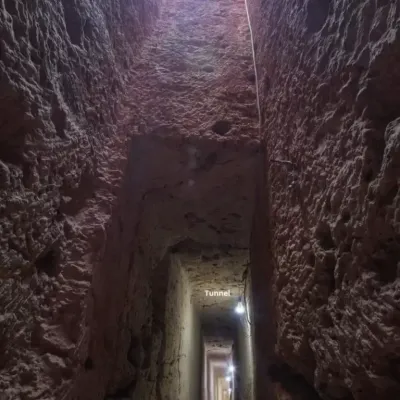 Taposiris Magna - Archaeologists recently discovered an underground tunnel, which may lead to the long-lost tomb of the Greek Queen of Egypt, Cleopatra, beneath Egypt’s ancient Taposiris Magna Temple. The Egyptian Ministry of Tourism and Antiquities announced the discovery in the Fall of 2022, describing the 1,300-meter tunnel located forty-three feet underground as a “geometric miracle.” It was said that it looks similar to the Tunnel of Eupalinos on the island of Samos in Greece. Excavations continue under the direction of Kathleen Martinez, an archaeologist at the University of San Domingo.
Taposiris Magna - Archaeologists recently discovered an underground tunnel, which may lead to the long-lost tomb of the Greek Queen of Egypt, Cleopatra, beneath Egypt’s ancient Taposiris Magna Temple. The Egyptian Ministry of Tourism and Antiquities announced the discovery in the Fall of 2022, describing the 1,300-meter tunnel located forty-three feet underground as a “geometric miracle.” It was said that it looks similar to the Tunnel of Eupalinos on the island of Samos in Greece. Excavations continue under the direction of Kathleen Martinez, an archaeologist at the University of San Domingo.
https://greekreporter.com/2023/05/20/tunnel-leading-cleopatra-tomb-found/
INDE - Raidurg - Archaeologists have found rare tools dating back to the neoliyhic period underneath the natural rock formation at BNRReddy Hills at Raidurg.This could well be the first time neolithic remains have been found in the city and could push the antiquity of Hyderabad back to 6,000 years.
ESPAGNE – 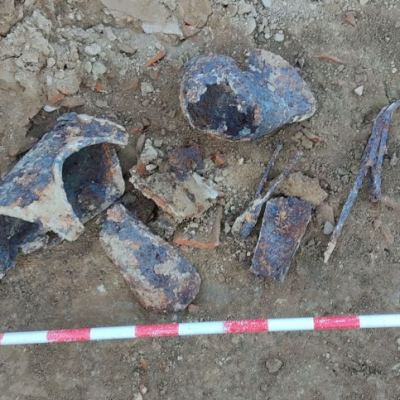 Matilla de los Caños del Río – Archaeologists have uncovered a complete suite of armour . The castle was previously thought to have been constructed following the Arab conquest of the Iberian Peninsula, which became part of Umayyad Caliphate around AD 711–732. However, very little is known about the history of the castle, with sources indicating that it was destroyed on the orders of Ferdinand II of Aragon in AD 1505. The castle ruins are located north of the village of Matilla de los Caños del Río on a small hill at a strategic position overlooking the flat plains below. Archaeologists have been conducting ongoing excavations since early 2023, revealing the layout of the castle interior and exterior walls. The team have identified the possible gateway entrance, a cistern, circular towers, and an armoury containing the remains of weapons and pieces of armour. According to the researchers, the archaeological evidence contradicts the historical narrative as they’ve found no evidence of Arab occupation or related architectural elements. The team have also discovered a complete suit of armour which dates from the 16th century. The armour consists of almost 50 pieces and was found alongside a crossbow and a knife. Speaking to Salamanca24horas, archaeologist Iván García Vázquez, said: “The armour has all its functional pieces, it consists of a helmet, breastplate, trellis, elbow pads, greaves and other protections for arms and legs.”Excavations also revealed numerous crossbow bolts, some of which have a socketed head almost square in cross section that was mainly used against armour, in addition to spike points that was used to penetrate chain mail. Also found among the ammunition cache are pieces of bolaño, a type of stone cannonball also known as “stoneshot”.
Matilla de los Caños del Río – Archaeologists have uncovered a complete suite of armour . The castle was previously thought to have been constructed following the Arab conquest of the Iberian Peninsula, which became part of Umayyad Caliphate around AD 711–732. However, very little is known about the history of the castle, with sources indicating that it was destroyed on the orders of Ferdinand II of Aragon in AD 1505. The castle ruins are located north of the village of Matilla de los Caños del Río on a small hill at a strategic position overlooking the flat plains below. Archaeologists have been conducting ongoing excavations since early 2023, revealing the layout of the castle interior and exterior walls. The team have identified the possible gateway entrance, a cistern, circular towers, and an armoury containing the remains of weapons and pieces of armour. According to the researchers, the archaeological evidence contradicts the historical narrative as they’ve found no evidence of Arab occupation or related architectural elements. The team have also discovered a complete suit of armour which dates from the 16th century. The armour consists of almost 50 pieces and was found alongside a crossbow and a knife. Speaking to Salamanca24horas, archaeologist Iván García Vázquez, said: “The armour has all its functional pieces, it consists of a helmet, breastplate, trellis, elbow pads, greaves and other protections for arms and legs.”Excavations also revealed numerous crossbow bolts, some of which have a socketed head almost square in cross section that was mainly used against armour, in addition to spike points that was used to penetrate chain mail. Also found among the ammunition cache are pieces of bolaño, a type of stone cannonball also known as “stoneshot”.
BULGARIE – 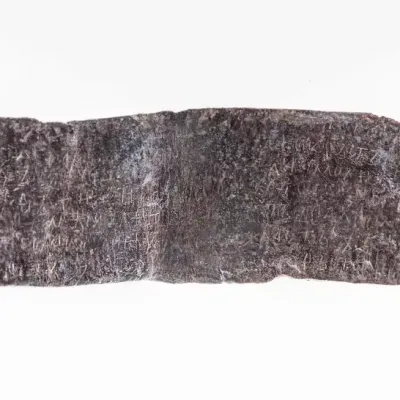 - A 1,100 year-old inscription found on a breastplate unearthed in the ruins of a Bulgarian fortress may be one of the oldest Cyrillic texts ever found. "The text was written on a lead plate worn on the chest to protect the wearer from trouble and evil," said Ivailo Kanev, an archaeologist with Bulgaria's National Museum who leads the team excavating the fortress, which is on the border between Greece and Bulgaria. The inscription refers to two supplicants named Pavel and Dimitar, Kanev said. "It is not known who the supplicants Pavel and Dimitar were, but most likely Dimitar participated in the garrison, settled in the fortress, and was a relative of Pavel," Kanev said. The inscription dates to the time of Tsar Simeon I (also known as Simeon the Great) who ruled the Bulgarian Empire between 893 and 927, said Kanev. During this time the tsar expanded the empire, launching military campaigns against the Byzantine Empire. The Cyrillic writing system, which is used in Russian and other languages across Eurasia, was developed during the Middle Ages. Based on how the letters are written and the location of the inscription within the fortress, "this text probably got into the fortress in the period between 916 and 927 and was brought by a Bulgarian military garrison," said Kanev.
- A 1,100 year-old inscription found on a breastplate unearthed in the ruins of a Bulgarian fortress may be one of the oldest Cyrillic texts ever found. "The text was written on a lead plate worn on the chest to protect the wearer from trouble and evil," said Ivailo Kanev, an archaeologist with Bulgaria's National Museum who leads the team excavating the fortress, which is on the border between Greece and Bulgaria. The inscription refers to two supplicants named Pavel and Dimitar, Kanev said. "It is not known who the supplicants Pavel and Dimitar were, but most likely Dimitar participated in the garrison, settled in the fortress, and was a relative of Pavel," Kanev said. The inscription dates to the time of Tsar Simeon I (also known as Simeon the Great) who ruled the Bulgarian Empire between 893 and 927, said Kanev. During this time the tsar expanded the empire, launching military campaigns against the Byzantine Empire. The Cyrillic writing system, which is used in Russian and other languages across Eurasia, was developed during the Middle Ages. Based on how the letters are written and the location of the inscription within the fortress, "this text probably got into the fortress in the period between 916 and 927 and was brought by a Bulgarian military garrison," said Kanev.